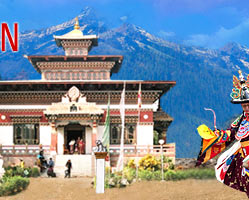The glaciers are fed by snowfalls during winter that melt slowly in summer. They cover about 10 percent of the total surface area of Bhutan and are important renewable source of fresh water to Bhutan and downriver areas each year. Melting of glaciers along with heavy rainfall in monsoons sometimes result in flooding too. For the past few decades, glacial lakes have been rapidly forming on the surface of the debris-covered glaciers in this region.
The river systems of Bhutan are:
- Drangme Chhu
- Puna Tsang Chhu or Sankosh,
- Wang Chhu, and
- Torsa Chhu.
Drangme Chhu
Drangme Chhu is the largest river system of Bhutan. It flows to the southwest and rises in the Indian state of Arunachal Pradesh It has three major branches that form Drangme Chhu basin together. They are:
- Drangme Chhu,
- Mangde Chhu, and
- Bumthang Chhu.
The Drangme Chhu basin spreads over most of eastern Bhutan, flowing through the Tongsa and Bumthang valleys, and is joined by eight tributaries in the Duars. In the Duars, it is known as the Manas Chhu.
Puna Tsang Chhu
Mo Chhu and Pho Chhu rising in northwestern Bhutan and fed by snow from the Great Himalayan Range, flow southwards towards Punakha, where they join to merge Puna Tsang Chhu. The 320 km long Puna Tsang Chhu flows to the south and enter West Bengal of India.
Wang Chhu
Wang Chhu rises in Tibet and flows southeasterly towards west-central Bhutan. It flows through Ha, Paro, and Thimphu valleys and then through Duars, where it is known as the Raigye Chhu. It flows into West Bengal and has tributaries that are 370 km long.
Torsa Chhu
It is the smallest river system and is known as the Amo Chhu towards north. This river system rises in Tibet, flows out of it into the Chumbi Valley, flows swiftly through western Bhutan, broadens near Phuntsholing and then flows into India.




